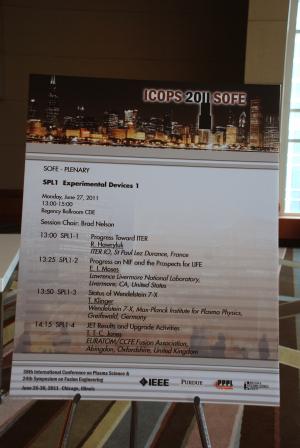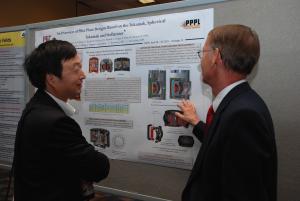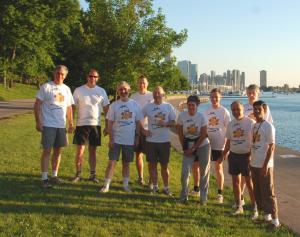SOFE calls for bolder steps forward
8 Jul 2011
-
Sabina Griffith
SOFE stands for vigorous interaction and information exchange between scientists and engineers from all major programs around the world.
Fireworks over Lake Michigan formed a spectacular finale to the 24th Symposium on Fusion Energy (SOFE) that took place in Chicago last week. The guests attending the conference banquet at the grand Adler Planetarium situated on the lakefront had gathered on the terrace to watch the show. While the rockets made their way up into the midnight sky, a sense of transition was in the air ... a transition that could catapult fusion research into the era of fusion energy.
"The vitality of fusion programs worldwide very much depends on the cross-fertilization of ideas," conference organizer Charles Neumeyer, Head of the Electrical Design Branch at the Princeton Plasma Physics Laboratory, said in his opening address. And, indeed, there seems to be no lack of ideas: 536 papers were submitted by authors from 38 nations to this latest edition of SOFE, as well as more than 80 student papers. This is "the next generation of plasma physicists," said Neumeyer.
For four days in a row, leading researchers from all of the world's fusion devices—including tokamaks, stellarators and lasers—presented the state of their art. As ITER now spearheads the world-spanning quest for fusion energy, it was up to ITER Deputy Director-General Rich Hawryluk to inaugurate the ball by reporting on the project's construction and manufacturing progress. More detailed reports on specific ITER design issues were presented during the course of the Symposium, attracting a good deal of interest.
On the evening of the opening day, it was less the technical issues of fusion development than the political ones that took centre stage. Over beer and chips, the fusion community discussed how to accelerate the development of fusion energy. "We have to quicken our pace, or the window of opportunity will close," warned Dale Meade, the spiritus rector of the Fusion Ignition Research Experiment (FIRE) and the host of what will make it into history books as the Town Hall Meeting. We have to take bolder steps or fusion will come too late!"
Among the speakers that evening was Ray Fonck, the former head of the US DOE Office of Fusion Energy Science. "The progress towards fusion energy is more resource-limited than knowledge-limited," Fonck proclaimed. "Within the present funding, fusion energy cannot be achieved. The decision to significantly increase funding to realize fusion energy will be driven by external events. The energy crisis has not yet hit this country, but it will come."
Jiangang Li, Professor at the Institute of Plasma Physics in Hefei and one of the leading fusion scientists in China, also spoke at the Town Hall Meeting and gave four highly attended talks during the SOFE week promoting a more courageous approach to fusion energy. And looking at the figures that Li projected onto the screens, a courageous approach indeed seems necessary...
In China, politicians have reacted by doubling the domestic budget for fusion research and—in news that made it around the world—the government will finance the education of 2,000 young fusion scientists. Li is convinced that within the next 20 years an electricity-producing pilot plant can be built, an EDEMO reactor as he calls it. "We have enough knowledge to take the risk," Li stressed, reminding the audience that nothing was perfect. "But we have to speed up. I would like to be the first user of fusion energy!"
Currently China is adding one new coal power plant to the grid every week. But this solution shall only feed the most urgent needs in terms of energy. "From now until 2050, the Chinese government plans to build 500 nuclear fission plants", Li stated. "Nuclear [fission] and renewables are strongly promoted in my country and we aim to cut our CO2 emissions by 40 percent by 2020." And so Li echoed Dale Meade's sentiment: "If we do not hurry, there will be no room for us!"
In China, politicians have reacted by doubling the domestic budget for fusion research and—in news that made it around the world—the government will finance the education of 2,000 young fusion scientists. Li is convinced that within the next 20 years an electricity-producing pilot plant can be built, an EDEMO reactor as he calls it. "We have enough knowledge to take the risk," Li stressed, reminding the audience that nothing was perfect. "But we have to speed up. I would like to be the first user of fusion energy!"
The vitality of the fusion program very much depends on the cross-fertilization of the ideas ... and on the vitality of its actors! The ITER team participating in the first biennial "Run for Endless Energy," a 5K fun race along Chicago's waterfront.
Another inspired speaker that night was Ned Sauthoff, Head of the US ITER Project office at Oak Ridge National Lab. "We have to treat fusion energy as real, with deliverables and schedules aimed at timely development, and not as a never ending research program" he said, encouraging the nations to take acceptable risks. "We have tended to avoid risks rather than manage risks. But we all know that we have to take prudent risks to make timely progress, and that one maximizes progress by a set of parallel tasks, most of which succeed but some of which teach us by outcomes that are not expected."
Having spent an evening discussing what bold steps to take to accelerate the pace of fusion development, two dozen jet-lagged SOFE attendees made their way to lakefront just after dawn the next morning to participate in a premiere: the first biennial "Run for Endless Energy," a 5K fun race along Chicago's waterfront.
Needless to say, the ITER team took up the challenge ...




